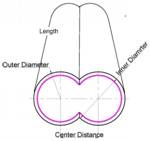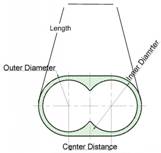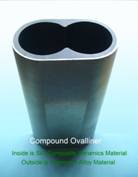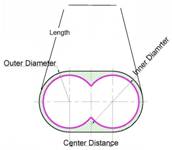Copyright © Shanghai Omega Machinery Co., Ltd. All rights reserved.
Twin Barrel Liners And Compared With Each Other
Mar 13,2017
This article try to compare with three kinds of twin barrel liner, to analyze the advantages and disadvantages of these lines from the material and structure severally.
A. Two C-shaped bimetallic liners docking assembly:
For this bimetallic C-shaped liners, common alloy layer is borides-iron cast with an excellent wear resistant feature named as Ω101, it is the same as X-102 alloy of XALOY company in USA and to be used widely in the twin extruder for modification market.

There is another working condition that if the raw material in the process is the polyvinyl chloride PVC, the chloridized polyvinyl chloride CPVC, the chloridized polytene CPE, the poly three vinyl fluoride CFE, the fluorinated polyethylene CM, the chlorinated polypropylene PPC, the poly tetrafluoroethylene PTFE, the poly ping acid PAA..., due to in all the processes of production, there are different degrees of corrosive gas volatilization, the gas will be into the gap and always corrode the liner metal, you see, the iron metal is too easy to be corroded.
So in most cases, the life end of C-shaped bimetallic liner, normally not because of worn-off, but the gap has been corroded, the closed angles to be damaged, so its service life is very limited.
B. One piece of an Oval Liner:
Compare with two C-shaped liners way above, one piece of an oval liner has at least three obvious advantages and to be welcomed by the market. One advantage is there is no joint gap because of the one piece only, users do not have to worry about polymer material staying inside the gap. There is no any dead area inside the barrel, that there is no any threat of pollution inside the material and have an excellent self-cleaning. Second is to avoid the stress inside two acute angles after two C-shaped liners docking, reducing the sharp crack threat of the brittle iron-base alloy layer. Third is in the need of more torque, higher screw speed and higher back working pressure of high-end parallel twin screw extruder, users will not worry about any risk of the liner rotation or liner displacement that may occur when two C-shaped liners to be used, the material drills into the gap resulting an additional pressure makes the C-shaped liners concave.

Sometimes for running some compounding modification of polymer materials, we have to face an extreme wear and corrosion working conditions, there is the SiC composite ceramic liner can be choosen. This ceramic liner is with high toughness and high wear & corrosion resistance which to be researched and developed by our company recently (Above figure). This new ceramic material can reach the flexural strength of 380MPa(σbb)and the compressive strength of 3970MPa(σbc), in addition to plane strain fracture toughness values of 4MPa/mm3/2(Κic), such physical parameters as security, that we can not have to worry about the crack issues of the corners. The heat conduction curve of SiC composite ceramic liner obtained in experiment can make us do not need to worry about the heat conduction properties ofSiC ceramic liner.

C. Bimetallic Oval Liner:
Inside two oval liner bores, there is an alloy protection layer, the alloy layer is generally cast in two ways, one is cast by ordinary sintering process, another is the use of powder metallurgy high temperature molding way of static pressure PM-HIP way. No matter which one of the above two methods, the alloy layer normally is the material of a nickel-base with tungsten carbide inside, this alloy named as Ω301 and it is the same as X-800 alloy of XALOY company in USA.. This kind of liner ordinarily to be used under both wear-resistant and corrosion resistant working conditions, such as we mentioned above, the raw material in the process is the polyvinyl chloride PVC, the chloridized polyvinyl chloride CPVC, the chloridized polytene CPE, the poly three vinyl fluoride CFE, the fluorinated polyethylene CM, the chlorinated polypropylene PPC, the poly tetrafluoroethylene PTFE, the poly ping acid PAA..., due to the Ω301 Ni-base alloy has low iron content, molecules are not quite active, with help of more WC tungsten carbide hard phases, can almost withstand all kinds of corrosion in an acidic atmosphere, or an alkaline gas when in the processing of polymer materials, will be very significant to extend the service life of the machines.

To check Ni-base Ω301 alloy in detail, please find our file [What time we have to use Ni-base Ω301 alloy].
If Ω301 alloy bimetallic oval liners will be used on a big extruder, one have to remind is that the thermal conductivity of nickel-base material is higher than other alloy, such as the cobalt-base alloy and Fe-base alloy in a large extent, so a user in the selection of nickel-base alloy material to be a protection layer, needs to re-adjust the extruder original temperature parameters.
There is also another problem with the temperature control for the twin extruders, that is we used to see some circular twin barrels to be used on the twin extruders, these circular barrels are made easily and with lower manufacturing cost, but our problem is for running polymer materials, in the demanding temperature control, with higher demands for the heat conduction efficiency of the mixing modified conditions, if the cooling/heating channel is so far away, isn't a user does not care about the operation cost of the extruder? Our view is that unless the barrel structure to be limited, but generally not recommended.
Chief Engineer Office / Shanghai Omega Machinery Co., Ltd
Prev News Next News- Information
- Why does overflow occur at the exhaust port of the extrusion main machine when producing ABS multi-layer composite plates? How should it be handled?
- What are the differences in the process when producing UPVC pipes by directly extruding PVC granules and powder?
- How should one select the molding equipment when generating PP water supply pipes?
- Why do the surfaces of extruded profiles have weld marks when extruding? What are the solutions to eliminate these marks?
- Why do large, dull and unreflective bubbles appear on the surface of the special profiles? How can this problem be solved?
- What causes the uneven surface and poor gloss of the sheet during the sheet extrusion process? How can it be solved?
- Why does the cooling process for profile extrusion become unbalanced?
- What countermeasures can be taken to improve the dimensional and positional accuracy of profiles during the profile production process?
- How should profile molds be cleaned and maintained?
- What are the corresponding solutions to the phenomenon of grooves and pits on the surface of profiles?
- Contact Us

-
Shanghai Omega Machinery Co., Ltd.
Add.: No.168 Hualian Road, Putuo District, Shanghai City
Contact: Nina
Tel.: +86-021-69921527
Mobile: +86-15021464410
Fax: +86-021-69921567
E-mail: omegajessica@163.com;965425705@qq.com
WeChat No.: 1131449532
Whatsapp: +86 159 0054 6558

-